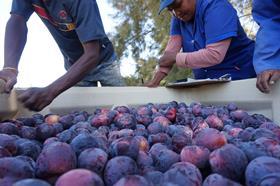
South African stonefruit growers exported significantly more fruit this year compared with last season, with all categories recording higher export volumes.
One would expect that it was therefore a very good season across the board, but nothing could be further from the truth.
These export volumes produced different results back on the farm for the various sectors. It is most pleasing to note that the harvest of plums grew significantly compared with last year, concluding the season 69 per cent higher.
It is a fact that plum growers who were looking to bounce back after three years of drought, however, have for most part not been able to break even on the farm.
Hortgro’s Jacques du Preez said that the apricot, peach and nectarine sectors did fairly well, with volumes increasing compared to last year and marketing conditions reasonable. “
'It is sad however that with such a big plum harvest, growers have to face the fact that it has not been a good season for them,' he explained. 'Looking at the last four years and the volumes of plums we produced, one gets the feeling that after years of drought we did realise our full potential from a production point of view.
'These are the kind of volumes we should be packing under good climatic conditions at this stage of the development of the industry,' Du Preez noted. 'Much of our off-season will therefore be denoted to talk about the future and to see how we can effectively deal with a crop that is still destined to increase in future.”
South Africa’s mid- to late-season forecast is more or less in line with market potential, he continued, noting that while it is obvious that much talk will centre around opening further markets, it is not something that happens overnight.
For the record, plum growers packed just over 15m cartons of fruit for the export market this year, compared with 8.8m cartons last year. Nectarines rose by 29 per cent to reach 6.5m cartons, while peaches accounted for 2.44m cartons, a rise of 22 per cent year-on-year.
The apricot season reflected a recovery after being decimated by drought in recent years. In the end 680,000 cartons were exported compared to last year’s 354,000 - an increase of 93 per cent.
The year was marked by a number of challenges, such as wind delays in Cape Town and reduced availability of containers. This resulted in market supply being affected.
At one point two container vessels arrived in Europe in the first week of January. This caused a price collapse and although volumes were cleared fairly quickly, the market never really recovered.



